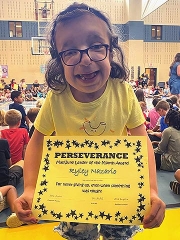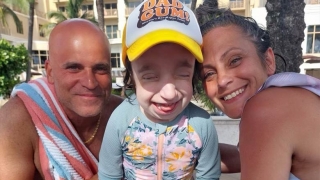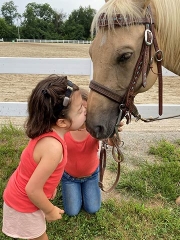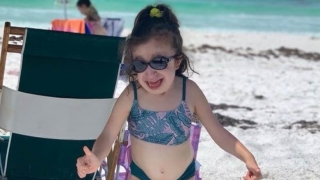Pfeiffer Syndrome: Ryley’s Story
Published on
Published on
 When 9-year-old Ryley’s parents, Vanessa and Jose, describe their daughter, they use words like “sassy” and “spunky.” Ryley was born with Pfeiffer syndrome, a complex genetic disorder characterized by differences of the skull, face and limbs. “There are things she can’t do physically,” Vanessa says, “but she definitely won’t be defined by it.”
When 9-year-old Ryley’s parents, Vanessa and Jose, describe their daughter, they use words like “sassy” and “spunky.” Ryley was born with Pfeiffer syndrome, a complex genetic disorder characterized by differences of the skull, face and limbs. “There are things she can’t do physically,” Vanessa says, “but she definitely won’t be defined by it.”
In Pfeiffer syndrome, one or more of the seams between the skull bones fuse together early in their development. This prevents the skull from growing normally, affecting the shape of the head and face and sometimes causing increased pressure around the brain. A depressed nasal bridge can interfere with breathing and swallowing. Occasionally, Pfeiffer syndrome also affects the hands and feet. Children with this condition might have broad, short thumbs, partial fusion of the second and third fingers. and big toes.
 A child with Pfeiffer syndrome undergoes several surgeries to repair these anomalies and treatments for issues such as breathing difficulties. Ryley’s first surgery to separate a seam in her skull was performed at Children's Hospital of Philadelphia (CHOP) two months after she was born. The list of procedures she has undergone at CHOP is 40 items long and includes a tracheostomy and multiple replacements of the breathing tube as she grew. Because Ryley also has a complex condition that affects her ribs and spine, she also needed casting to straighten her curved spine and rods implanted to expand her ribs so her lungs can grow, using a device invented at CHOP.
A child with Pfeiffer syndrome undergoes several surgeries to repair these anomalies and treatments for issues such as breathing difficulties. Ryley’s first surgery to separate a seam in her skull was performed at Children's Hospital of Philadelphia (CHOP) two months after she was born. The list of procedures she has undergone at CHOP is 40 items long and includes a tracheostomy and multiple replacements of the breathing tube as she grew. Because Ryley also has a complex condition that affects her ribs and spine, she also needed casting to straighten her curved spine and rods implanted to expand her ribs so her lungs can grow, using a device invented at CHOP.
 After she had surgery at age 5 to reposition her facial bones, she was fitted with a device with screws that needed to be turned to move the bones slowly over several weeks. Amazingly, she turned the screws herself. Vanessa reports that when Ryley’s surgeon, Scott Bartlett, MD, saw videos of her doing this, he was “floored by her. He wanted us to post the videos online because people are so scared of this device!”
After she had surgery at age 5 to reposition her facial bones, she was fitted with a device with screws that needed to be turned to move the bones slowly over several weeks. Amazingly, she turned the screws herself. Vanessa reports that when Ryley’s surgeon, Scott Bartlett, MD, saw videos of her doing this, he was “floored by her. He wanted us to post the videos online because people are so scared of this device!”
Through it all, Ryley has remained positive. She enjoys playing Nintendo and Roblox, drawing, singing and dancing, and she’s begun taking piano lessons. “After she got her trach removed, she could swim,” Vanessa reports. “This summer, she was diving under the waves at the ocean, which was great to see.”
The family is very active in the craniofacial community. In June, they attended the Children’s Craniofacial Association retreat, and Vanessa says Ryley’s personality shone through: “When people asked, ‘What do you have?’ she said, ‘I don’t have anything — I am who I am!’”
Jose laughs recalling this: “The things that come out of her mouth!”
 Vanessa and Jose have created a pamphlet that they supply to Ryley’s school and ask to be sent to her classmates’ parents. It begins, “I see that you noticed I am a little different than you, and you may be wondering why.” Then they supply a full explanation of Pfeiffer syndrome. On one panel, over a photo of Ryley looking sharp in oversized sunglasses, they’ve included a saying that sums her up: “I’m thankful for my struggle, because without it, I wouldn’t have stumbled across my strength.”
Vanessa and Jose have created a pamphlet that they supply to Ryley’s school and ask to be sent to her classmates’ parents. It begins, “I see that you noticed I am a little different than you, and you may be wondering why.” Then they supply a full explanation of Pfeiffer syndrome. On one panel, over a photo of Ryley looking sharp in oversized sunglasses, they’ve included a saying that sums her up: “I’m thankful for my struggle, because without it, I wouldn’t have stumbled across my strength.”